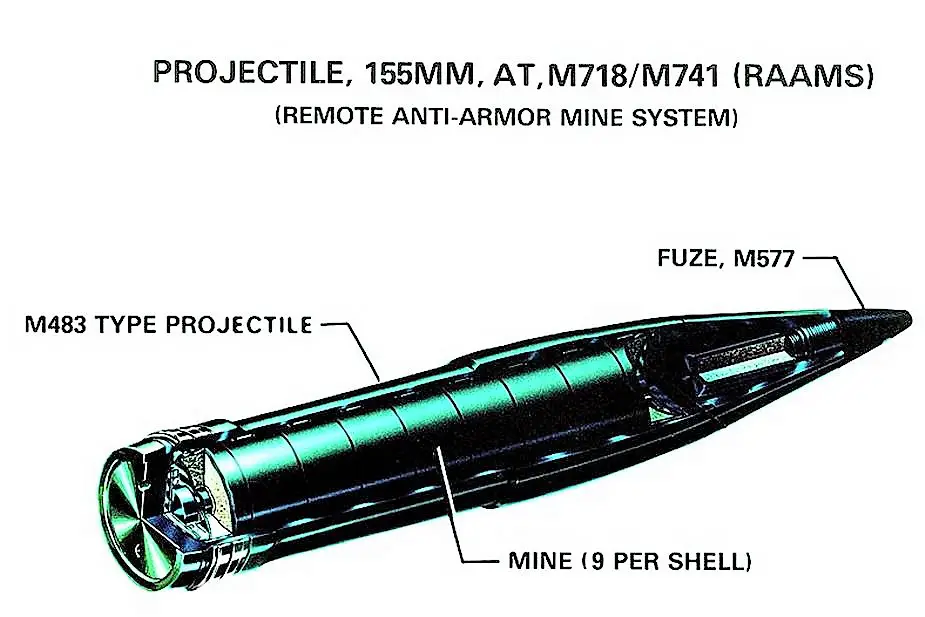Ukrainian army gets devasting successes using Remote-Anti-Armour Mine systems
According to a tweet posted on March 16 by the British Ministry of Defense, a factor of the Russians’ heavy losses in the Vuhledar sector has been Ukraine’s successful adoption of Remote-Anti-Armour Mine (RAAM) systems.
Follow Army Recognition on Google News at this link

Way of working of a Remote-Anti-Armour Mine (RAAM) (Picture source: D.R.)
The development of RAAMs dates back to around 1980. RAAM is a special artillery shell that scatters anti-armour mines up to 17km away from the firing unit. In some instances, Uraine has launched mines over and behind advancing Russian units, causing disarray when Russian vehicles attempted to withdraw.
The Remote Anti-Armor Mine System (RAAMS) are two types of 155mm howitzer projectiles containing nine anti-tank mines each:
• the M718 or M718A1 (RAAM-L) with a self-destruct time over 24 hours,
• the M741 or M741A1 (RAAM-S) with a self-destruct time under 24 hours.
Both projectiles are used with the M577 or M577A1 Mechanical Time and Superquick (MTSQ) fuze, which triggers the ejection mechanism of the mines above enemy territory after a preset time.
These mines can be delivered at ranges from 4 to 17.6 kilometers (2.5 to 10.9 mi) from the artillery battery position using either the M109 series, M198 or M777 series howitzers.
By January 2023, the US had sent approximately 10,200 rounds to Ukraine since the start of the Russian invasion of Ukraine in February 2022.

Remote-Anti-Armour Mine (RAAM) (Picture source: Wikipedia)
Equivalent to the RAAM system
Area Denial Artillery Munition (ADAM)
is a family of U.S. land mines and 155 mm artillery projectiles. The mines carried by these projectiles are the M67 long-duration anti-personnel mines and M72 short-duration anti-personnel landmines intended to maim or kill enemy combatants. The duration refers to the self-destruct time, which is set at the time of manufacture to 4 or 48 hours.
Once the mine lands, it launches seven tripwires before arming itself. Any disturbance of the tripwires will trigger the mine. The mine is entirely electrically detonated, if the battery level of the mine drops below a pre-set level - the mine self-destructs. Even if the mine does not self-destruct, the battery will fully discharge after 14 days, rendering the mine inactive.
The mines contain a spherical warhead in a void that also contains 51 grams (1.8 oz) of M10 liquid propellant. The void allows the propellant fluid to settle under gravity in the correct position beneath the warhead so that the warhead is always launched in an upward direction irrespective of the initial orientation of the mine.
Upon activation the spherical warhead is launched upward to a height of 1 to 2 meters (3.3 to 6.6 ft), where it detonates, producing approximately 600 fragments travelling at a velocity of 900 meters per second (3,000 ft/s).

Area Denial Artillery Munition (ADAM) (Picture source: D.R.)
Family of Scatterable Mines (FASCAM)
Family of Scatterable Mines (FASCAM) is an umbrella term for a range of systems of the armed forces of the United States, which allows a maneuver commander to rapidly place mines as a situational obstacle; as a reserve obstacle emplacement capability; and to directly attack enemy formations through disrupt, fix, turn, and block. Modern fusing, sensing, and anti-disturbance devices allow scatterable mines to defeat enemy attempts to reduce and/or clear the minefield. FASCAM mines are delivered through artillery, rocket launchers, indirect crew-served weapons, special mine-sowing vehicles, helicopters and aircraft. FASCAM mines utilize a random or pre-programmed self-destruct period, countermeasure hardening and anti-disturbance features. All FASCAM mines have an active life cycle and self-destruct (SD) time after their active life has expired. The duration of the active life varies from 4 hours to 15 days depending on the system.
Systems that are part of the FASCAM range include:
* Remote Anti-Armor Mine System (RAAMS) (a 155mm howitzer shell)
* Area Denial Artillery Munition (ADAM) (a 155mm howitzer shell)
* GATOR mine system (air-dropped)
* Volcano mine system (various vehicles)
* GEMSS mine system (various vehicles)
* Modular Pack Mine System (MOPMS) (a manually emplaced mine dispenser consisting of 17 AT and 4 AP mines released on command from a remote control system)
Defense News March 2023




























